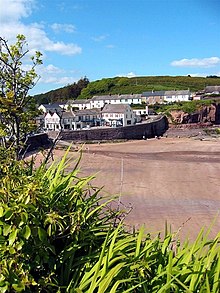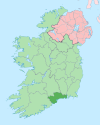Decies
Geography and subdivisions
County Waterford has two mountain ranges, the Knockmealdown Mountains and the Comeragh Mountains. The highest point in the county is Knockmealdown, at 794 m (2,605 ft). It also has many rivers, including Ireland's third-longest river, the River Suir (184 km (114 mi)); and Ireland's fourth-longest river, the Munster Blackwater (168 km (104 mi)). There are over 30 beaches along Waterford's volcanic coastline. A large stretch of this coastline, known as the Copper Coast, has been designated as a UNESCO Geopark, a place of great geological importance. To the west of Dungarvan is the Déise Gaeltacht, an Irish-speaking region comprising the areas of Ring, County Waterford and Old Parish.
Waterford is the county seat; prior to the merger of the 2 Waterford authorities in June 2014 Dungarvan was the county seat for Waterford County Council.
Baronies
There are eight historic baronies in the county: Coshmore and Coshbride, Decies-within-Drum, Decies-without-Drum, Gaultiere, Glenahiry, Middlethird, Upperthird and Waterford City.
Largest towns
| Year | Pop. | ±% |
|---|---|---|
| 1600 | 14,456 | — |
| 1610 | 9,887 | −31.6% |
| 1653 | 13,136 | +32.9% |
| 1659 | 13,286 | +1.1% |
| 1821 | 76,103 | +472.8% |
| 1831 | 85,217 | +12.0% |
| 1841 | 196,187 | +130.2% |
| 1851 | 164,035 | −16.4% |
| 1861 | 134,252 | −18.2% |
| 1871 | 123,310 | −8.2% |
| 1881 | 112,768 | −8.5% |
| 1891 | 98,251 | −12.9% |
| 1901 | 87,187 | −11.3% |
| 1911 | 83,966 | −3.7% |
| 1926 | 78,562 | −6.4% |
| 1936 | 77,614 | −1.2% |
| 1946 | 76,108 | −1.9% |
| 1951 | 75,061 | −1.4% |
| 1956 | 74,031 | −1.4% |
| 1961 | 71,439 | −3.5% |
| 1966 | 73,080 | +2.3% |
| 1971 | 77,315 | +5.8% |
| 1979 | 87,278 | +12.9% |
| 1981 | 88,591 | +1.5% |
| 1986 | 91,151 | +2.9% |
| 1991 | 91,624 | +0.5% |
| 1996 | 94,680 | +3.3% |
| 2002 | 101,546 | +7.3% |
| 2006 | 107,961 | +6.3% |
| 2011 | 113,795 | +5.4% |
| 2016 | 116,176 | +2.1% |
| 2022 | 127,363 | +9.6% |
| Rank | Town | Population (2022 census) |
|---|---|---|
| 1 | Waterford | 60,079 |
| 2 | Tramore | 11,277 |
| 3 | Dungarvan | 10,081 |
| 4 | Portlaw | 1,881 |
| 5 | Dunmore East | 1,731 |
| 6 | Ballinroad | 1,389 |
| 7 | Lismore | 1,347 |
| 8 | Tallow | 1,022 |
History

County Waterford is colloquially known as "The Déise", pronounced "day-shah" or, in Irish, /dʲe:ʃʲɪ/ (Irish: Na Déise). Some time between the 4th and 8th centuries, an Irish tribe called the Déisi were driven from southern county Meath/north Kildare and moved into the Waterford region, conquering and settling there. The ancient principality of the Déise is today roughly coterminous with the current Roman Catholic Diocese of Waterford and Lismore thus including part of south County Tipperary.
The westernmost of the baronies are Decies-within-Drum and Decies-without-Drum, separated by the Drum-Fineen hills.

There are many megalithic tombs and ogham stones in the county. The Viking influence can still be seen with Reginald's Tower, one of the first buildings to use a brick and mortar construction method in Ireland. Woodstown, a settlement dating to the 9th century, was discovered 5.5 kilometers (3.4 miles) west of Waterford city. It was the largest settlement outside Scandinavia and the only large-scale 9th-century Viking settlement discovered to date in Western Europe. Other architectural features are products of the Anglo-Norman invasion of Ireland and its effects.
Local government and politics
As of 1 June 2014, Waterford City and County Council is the local government authority for the local government area of Waterford City and County. The authority was formed following the merger of the local government areas of the county of Waterford and the city of Waterford under the Local Government Reform Act 2014, and succeeded the functions of Waterford City Council and Waterford County Council. The local authority is responsible for certain local services such as sanitation, planning and real-estate development, libraries, the collection of automobile taxation, local roads and social housing.
For elections to Dáil Éireann, the county is represented by the 4-seat constituency of Waterford. For European elections, the city and county are part of the 5-seat South constituency.
Gaeltacht
Gaeltacht na nDéise is a Gaeltacht area in County Waterford, consisting of the parish of An Rinn and An Sean Phobal. Gaeltacht na nDéise is located 10 kilometres (6.2 miles) from the town of Dungarvan, has a population of 1,816 people (Census 2016) and encompasses a geographical area of 62 km. According to Census 2016 the percentage of daily Irish speakers in Gaeltacht na nDéise was 45.6%.
Culture
- In the Willows, alternative folk band from Waterford
See also

- High Sheriff of County Waterford
- Lord Lieutenant of Waterford
- List of abbeys and priories in the Republic of Ireland (County Waterford)
- Saint Declan
- Limerick–Rosslare railway line
References
- ^ "A Short History of County Waterford" (PDF). waterfordcoco.ie. Waterford County Council. Archived (PDF) from the original on 18 November 2017. Retrieved 7 August 2021.
- ^ "County Profiles – Waterford" (PDF). Teagasc. Retrieved 24 November 2023.
- ^ "Interactive Data Visualisations: Local Authorities (County Councils): WATERFORD CITY AND COUNTY COUNCIL". Census 2022. Central Statistics Office. Retrieved 26 September 2023.
- ^ "Geology of the Copper Coast – Copper Coast Geopark". Copper Coast Geopark. Archived from the original on 1 February 2018. Retrieved 31 January 2018.
- ^ "Waterford County Council website". Archived from the original on 11 April 2011. Retrieved 9 April 2011.
- ^ "Census 2016 Sapmap Area: County Waterford City And County". Central Statistics Office (Ireland). Archived from the original on 18 November 2018. Retrieved 18 November 2018.
- ^ For 1653 and 1659 figures from Civil Survey Census of those years, Paper of Mr Hardinge to Royal Irish Academy 14 March 1865.
- ^ "Census for post 1821 figures". CSO. Archived from the original on 9 March 2005. Retrieved 8 August 2014.
- ^ histpop.org Archived 7 May 2016 at the Wayback Machine
- ^ "NISRA – Northern Ireland Statistics and Research Agency (c) 2013". Nisranew.nisra.gov.uk. 27 September 2010. Archived from the original on 17 February 2012. Retrieved 2014-08-08.
- ^ Lee, J. J. (1981). "On the accuracy of the Pre-famine Irish censuses". In Goldstrom, J. M.; Clarkson, L. A. (eds.). Irish Population, Economy, and Society: Essays in Honour of the Late K. H. Connell. Oxford, England: Clarendon Press.
- ^ Mokyr, Joel; Ó Gráda, Cormac (November 1984). "New Developments in Irish Population History, 1700–1850". The Economic History Review. 37 (4): 473–488. doi:10.1111/j.1468-0289.1984.tb00344.x. hdl:10197/1406. Archived from the original on 4 December 2012. Retrieved 3 September 2009.
- ^ "Census 2022 - F1015 Population". Central Statistics Office Census 2022 Reports. Central Statistics Office Ireland. August 2023. Retrieved 16 September 2023.
- ^ Egan, P.M. (20 November 2004) [1893]. "Early Waterford History 2. The Decies". History of Waterford. Archived from the original on 26 May 2008. Retrieved 23 February 2008.
- ^ "Prehistoric Waterford tombs, dolmens and standing stones". Prehistoricwaterford.com. Archived from the original on 29 December 2011. Retrieved 10 April 2011.
- ^ Local Government Reform Act 2014, s. 13: Establishment of local authorities for certain local government areas (No. 1 of 2014, s. 13). Enacted on 27 January 2014. Act of the Oireachtas. Retrieved from Irish Statute Book on 10 January 2022.
- ^ Electoral (Amendment) (Dáil Constituencies) Act 2017, Schedule (No. 39 of 2017, Schedule). Enacted on 23 December 2017. Act of the Oireachtas. Retrieved from Irish Statute Book on 10 January 2022.
- ^ European Parliament Elections (Amendment) Act 2019, s. 7: Substitution of Third Schedule to Principal Act (No. 7 of 2019, s. 7). Enacted on 12 March 2019. Act of the Oireachtas. Retrieved from Irish Statute Book on 10 January 2022.
- ^ "Archived copy". Central Statistics Office. Archived from the original on 28 July 2020. Retrieved 17 January 2022.
{{cite web}}: CS1 maint: archived copy as title (link)

